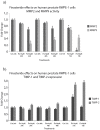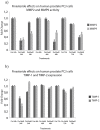Finasteride inhibits human prostate cancer cell invasion through MMP2 and MMP9 downregulation
- PMID: 24386413
- PMCID: PMC3875555
- DOI: 10.1371/journal.pone.0084757
Finasteride inhibits human prostate cancer cell invasion through MMP2 and MMP9 downregulation
Abstract
Introduction: The use of the 5-alpha reductase inhibitors (5-ARIs) finasteride and dutasteride for prostate cancer prevention is still under debate. The FDA recently concluded that the increased prevalence of high-grade tumors among 5-ARI-treated patients must not be neglected, and they decided to disallow the use of 5-ARIs for prostate cancer prevention. This study was conducted to verify the effects of finasteride on prostate cell migration and invasion and the related enzymes/proteins in normal human and tumoral prostatic cell lines.
Materials and methods: RWPE-1, LNCaP, PC3 and DU145 cells were cultivated to 60% confluence and exposed for different periods to either 10 µM or 50 µM finasteride that was diluted in culture medium. The conditioned media were collected and concentrated, and MMP2 and MMP9 activities and TIMP-1 and TIMP-2 protein expression were determined. Cell viability, migration and invasion were analyzed, and the remaining cell extracts were submitted to androgen receptor (AR) detection by western blotting techniques. Experiments were carried out in triplicate.
Results: Cell viability was not significantly affected by finasteride exposure. Finasteride significantly downregulated MMP2 and MMP9 activities in RWPE-1 and PC3 cells and MMP2 in DU145 cells. TIMP-2 expression in RWPE-1 cells was upregulated after exposure. The cell invasion of all four tested cell lines was inhibited by exposure to 50 µM of finasteride, and migration inhibition only occurred for RWPE-1 and LNCaP cells. AR was expressed by LNCaP, RWPE-1 and PC3 cells.
Conclusions: Although the debate on the higher incidence of high-grade prostate cancer among 5-ARI-treated patients remains, our findings indicate that finasteride may attenuate tumor aggressiveness and invasion, which could vary depending on the androgen responsiveness of a patient's prostate cells.
Conflict of interest statement
Figures







Similar articles
-
Crude extract of Euphorbia formosana inhibits the migration and invasion of DU145 human prostate cancer cells: The role of matrix metalloproteinase-2/9 inhibition via the MAPK signaling pathway.Mol Med Rep. 2013 May;7(5):1403-8. doi: 10.3892/mmr.2013.1380. Epub 2013 Mar 20. Mol Med Rep. 2013. PMID: 23525212
-
Differential regulation of matrix metalloproteinase-9, tissue inhibitor of metalloproteinase-1 (TIMP-1) and TIMP-2 expression in co-cultures of prostate cancer and stromal cells.Int J Cancer. 2001 Aug 15;93(4):507-15. doi: 10.1002/ijc.1358. Int J Cancer. 2001. PMID: 11477554
-
Fibronectin induces MMP2 expression in human prostate cancer cells.Biochem Biophys Res Commun. 2013 Jan 25;430(4):1319-21. doi: 10.1016/j.bbrc.2012.12.031. Epub 2012 Dec 19. Biochem Biophys Res Commun. 2013. PMID: 23261429
-
Finasteride.Expert Opin Drug Metab Toxicol. 2010 Jul;6(7):873-81. doi: 10.1517/17425255.2010.495944. Expert Opin Drug Metab Toxicol. 2010. PMID: 20536414 Review.
-
Prostate cancer prevention with 5-alpha reductase inhibitors: concepts and controversies.Curr Opin Urol. 2018 Jan;28(1):42-45. doi: 10.1097/MOU.0000000000000464. Curr Opin Urol. 2018. PMID: 29095730 Review.
Cited by
-
Antimetastatic activity of novel ruthenium (III) pyridine complexes.Cancer Med. 2016 Oct;5(10):2850-2860. doi: 10.1002/cam4.826. Epub 2016 Sep 7. Cancer Med. 2016. PMID: 27605356 Free PMC article.
-
Roles of matrix metalloproteinases and their natural inhibitors in prostate cancer progression.Cancers (Basel). 2014 Jun 27;6(3):1298-327. doi: 10.3390/cancers6031298. Cancers (Basel). 2014. PMID: 24978435 Free PMC article.
-
Changes in the expression of cancer- and metastasis-related genes and proteins after metformin treatment under different metabolic conditions in endometrial cancer cells.Heliyon. 2023 May 25;9(6):e16678. doi: 10.1016/j.heliyon.2023.e16678. eCollection 2023 Jun. Heliyon. 2023. PMID: 37313172 Free PMC article.
-
Genome-scale integrated analysis to identify prospective molecular mechanisms and therapeutic targets in isocitrate dehydrogenase 2 R140Q-mutated acute myeloid leukemia.Oncol Rep. 2019 May;41(5):2876-2888. doi: 10.3892/or.2019.7075. Epub 2019 Mar 18. Oncol Rep. 2019. PMID: 30896832 Free PMC article.
-
The MMP2 rs243865 polymorphism increases the risk of prostate cancer: A meta-analysis.Oncotarget. 2017 May 19;8(42):72933-72938. doi: 10.18632/oncotarget.18014. eCollection 2017 Sep 22. Oncotarget. 2017. PMID: 29069837 Free PMC article.
References
-
- Racioppi M, Palermo G, D’Addessi A, Pinto F, Sacco E, et al. (2012) Hot topics in urological health economics. A mini review. Arch Ital Urol Androl 84: 47–52. - PubMed
-
- Klein EA, Thompson IM (2012) Chemoprevention of prostate cancer: an updated view. World J Urol 30: 189–194. - PubMed
-
- Cussenot O, Azzouzi AR, Nicolaiew N, Mangin P, Cormier L, et al. (2007) Low-activity V89L variant in SRD5A2 is associated with aggressive prostate cancer risk: an explanation for the adverse effects observed in chemoprevention trials using 5-alpha-reductase inhibitors. Eur Urol 52: 1082–1087. - PubMed
-
- Das K, Lorena PD, Ng LK, Lim D, Shen L, et al. (2010) Differential expression of steroid 5alpha-reductase isozymes and association with disease severity and angiogenic genes predict their biological role in prostate cancer. Endocr Relat Cancer 17: 757–770. - PubMed
-
- Thompson IM, Klein EA, Lippman SM, Coltman CA, Djavan B (2003) Prevention of prostate cancer with finasteride: US/European perspective. Eur Urol 44: 650–655. - PubMed
Publication types
MeSH terms
Substances
LinkOut - more resources
Full Text Sources
Other Literature Sources
Medical
Research Materials
Miscellaneous

